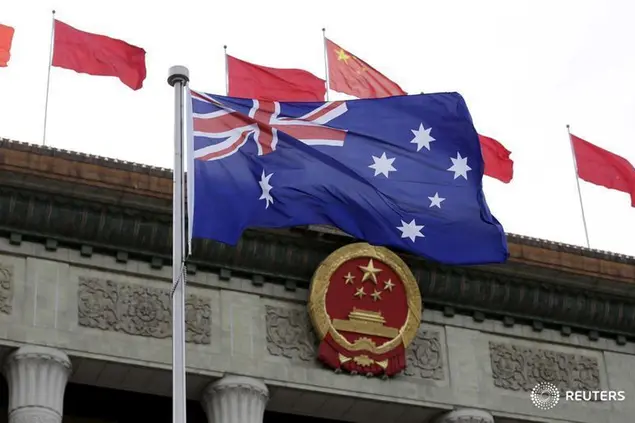PHOTO
When Australia’s leaders are developing their strategy for the Indo-Pacific, they have to take account of China’s ambitions in the region.
Although both countries had healthy trade ties until recently, cracks are appearing in their relationship, which is causing instability in the region. This has wider security implications for many other countries and affects the ability to defend against China’s assertive behavior.
The downturn between Australia and China is driven both by geopolitics and geoeconomics. The gloves are off in an escalating trade dispute between the two nations, after Beijing slapped huge tariffs on exports, jeopardizing trade worth billions of dollars.
But the political undercurrents of the bilateral relationship began to shift a few years ago. A Chinese influence-peddling scandal led to the resignation of an Australian senator in December 2017. The following year Australia was the first country to ban 5G equipment made by Chinese telecoms company Huawei.
When the coronavirus (COVID-19) pandemic began, Australian Prime Minister Scott Morrison suggested that the WHO should send experts to China to discover more about the origins of the pathogen. In response, Beijing imposed tariffs on Australian barley, and blocked imports of beef and coal.
Relations deteriorated further following the recent apology by Australian officials for the behavior of some of their servicemen in Afghanistan. Zaho Lijian, a spokesman for China’s Foreign Ministry, tweeted a fabricated image of an Australian soldier holding a knife to the throat of an Afghan child.
Australia’s view of China is based on observing its political growth, from the 1911 Revolution through to the Cultural Revolution of the 1960s and 1970s. Beijing is making rapid progress toward economic modernization, but the Communist Party continues to expand and control the main engines of power.
There is no question that China is rapidly integrating into the global economy — in fact it is emerging as one of the world’s leading economies — but Beijing does not conform to the established norms of international affairs and rule of law.
The Chinese government questions the right of outside powers, such as Australia, to challenge its sovereignty over Tibet, Hong Kong or Taiwan, its intrusion into the South China Sea or its actions in Xinjiang. These are viewed in Australia as major policy concerns but any attempt by Canberra to question these actions or express concern is regarded by Chinese authorities as an act hostile to the interests of the entire nation.
This is the situation the Australian government must contend with. China will be an increasingly important part of discussion about Australia’s foreign policies in terms of Indo-Pacific security, especially in Southeast Asia.
Taiwan, which might face a major challenge next year if Beijing decides to occupy it, certainly factors into Australia’s security concerns. Any move by Canberra to protest or intervene is likely to be met by a Chinese response that disrupts bilateral relations. The resultant lack of communication could cause the dispute to spread to other parts of the Indo-Pacific where Chinese and Australian interests might collide, such as Malaysia or the Philippines.
While Taiwan remains the biggest strategic question, the status of Taiwan and Canberra’s dealings with the government in Taipei are just two issues that are matters of great sensitivity in relations between Australia and China. Others include human rights, the treatment of the Tibetan people, the conduct of aid and economic relations, and Australia's alliance with the US.
Individually, these issues generally have been managed without major incident so far, and even the relationship between Canberra and Taipei is tacitly accepted by Beijing.
There is no doubt, however, that the security environment is changing from the Australian point of view. Canberra’s relationships with India and Japan are becoming more relevant as it attempts to metaphorically surround China.
New Delhi and Tokyo signed an agreement in September to use each other’s maritime bases and facilities for repairs and the replenishment of supplies, as part of an effort to boost overall defense and security cooperation.
The increased military activity of the Chinese People’s Liberation Army in Ladakh and Beijing’s sovereignty claims over Japan’s Senkaku Islands is forcing Canberra to adjust its security plans for the Indo-Pacific region. The agreement by India and Japan complements the Quad alliance between those two nations, Australia and the US, which involves semi-regular summits, exchange of information and military drills.
France might also be joining this strategic alliance, and is due to participate in upcoming naval exercises. French President Emmanuel Macron spoke in September of the need for a strategic alliance with India and Australia to counter Chinese assertiveness.
Canberra welcomes this French initiative, up to and including access to military bases. The foreign ministers of the three countries have discussed the pact, which has been in the works for the past two years. This latest development puts Australia, and the other Quad members, on course for a showdown with China in 2021.
- Dr. Theodore Karasik is a senior adviser to Gulf State Analytics in Washington, D.C. He is a former RAND Corporation senior political scientist who lived in the UAE for 10 years, focusing on security issues. Twitter: @tkarasik
Copyright: Arab News © 2020 All rights reserved. Provided by SyndiGate Media Inc. (Syndigate.info).
